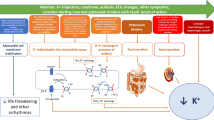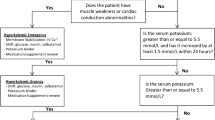Abstract
Pseudohyperkalaemia was observed in 3 of 16 patients with Kawasaki disease showing remarkably increased platelet counts. Their plasma potassium concentration, which is not affected by in vitro coagulation, was in the normal range despite the increased serum level. A significant correlation was observed between the platelet count and the increase in the serum potassium level resulting from blood coagulation, which was estimated by subtracting the plasma potassium level from the serum level. This study indicates that pseudohyperkalaemia should be considered in patients with Kawasaki disease whose platelet counts are markedly increased.
Similar content being viewed by others
References
Bellevue R, Dosik H, Spergel G, Bernard D, Gussoff BD (1975) Pseudohyperkalemia in extreme leukocytosis. J Lab Clin Med 85:660–664
Burns JC, Glode MP, Clarke SH, Wiggins J, Hathaway WE (1984) Coagulopathy and platelet activation in Kawasaki syndrome: identification of patients at high risk for development of coronary artery aneurysms. J Pediatr 105:206–211
Chumbley LC (1970) Pseudohyperkalemia in acute myeloid leukemia. JAMA 211:1007–1009
Dagher G, Vantyghem MC, Doise B, Lallau G, Racadot A, Lefebvre J (1989) Altered erythrocyte cation permeability in familial pseudohyperkalaemia. Clin Sci 77:213–216
Hartmann RC, Mallinkoff SM (1955) The relationship of platelets to the serum potassium concentration. J Clin Invest 34:938
Hartmann RC, Auditore JV, Jackson DP (1958) Studies on thrombocytosis: I. Hyperkalemia due to release of potassium from platelets during coagulation. J Clin Invest 37:699–707
Hicks RY, Melish ME (1986) Kawasaki syndrome. Pediatr Clin North Am 33:1151–1175
Ho-Yen DO, Pennington CR (1980) Pseudohyperkalaemia and infectious mononucleosis. Postgrad Med J 56:435–436
Kawasaki T, Kosaki F, Okawa S, Shigematsu I, Yanagawa H (1974) A new infant febrile mucocutaneous lymph node syndrome (MCLS) prevailing in Japan. Pediatrics 54:271–276
Kerr DJ, McAlpine LG, Dagg JH (1985) Pseudohyperkalaemia. BMJ 291:890–891
Myerson RM, Frumili AM (1960) Hyperkalemia associated with myeloproliferative disorders. Arch Intern Med 106:479–482
Stewart GW, Corrall RJM, Fyffe JA, Stockdill G, Strong JA (1979) Familial pseudohyperkalaemia: a new syndrome. Lancet II:175–177
Whitfield JB (1966) Spurious hyperkalaemia and hyponatraemia in a patient with thrombocythaemia. J Clin Path 19:496–497
Wills MR, Fraser ID (1964) Spurious hyperkalaemia. J Clin Path 17:649–650
Author information
Authors and Affiliations
Rights and permissions
About this article
Cite this article
Shimizu, T., Yamashiro, Y. & Yabuta, K. Pseudohyperkalaemia in Kawasaki disease. Eur J Pediatr 151, 497–498 (1992). https://doi.org/10.1007/BF01957752
Received:
Accepted:
Issue Date:
DOI: https://doi.org/10.1007/BF01957752




